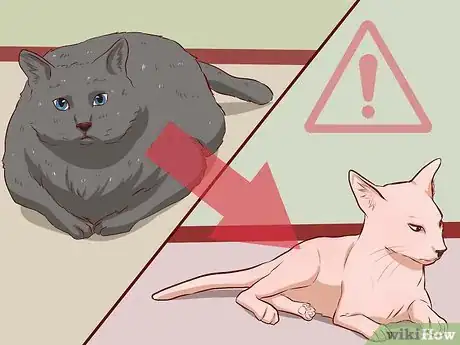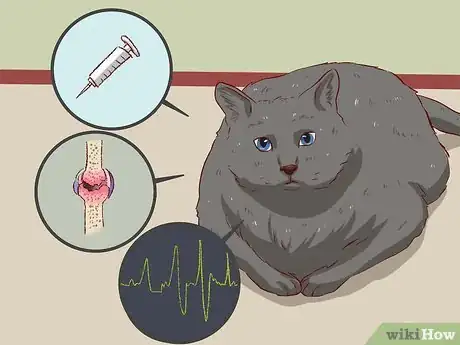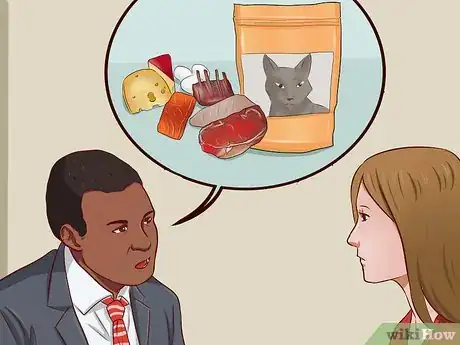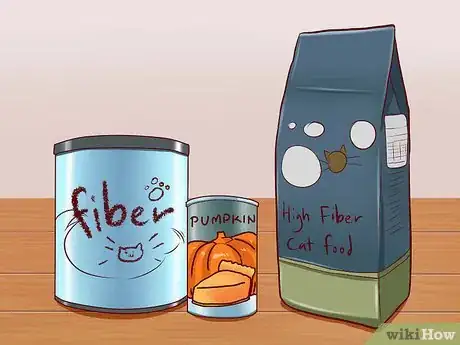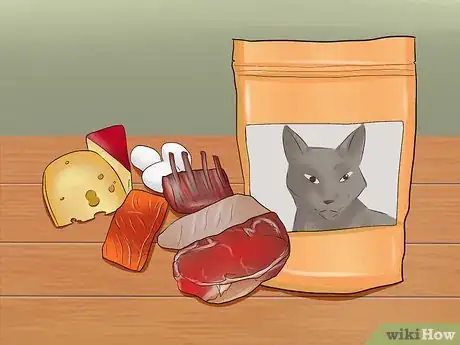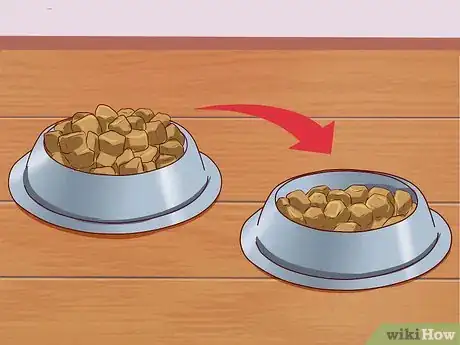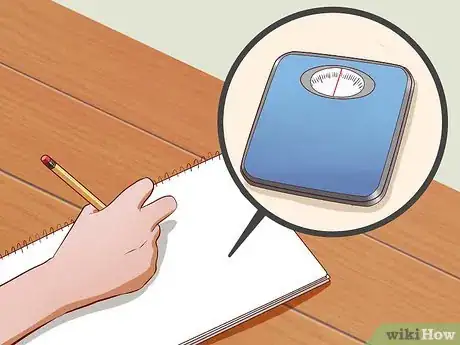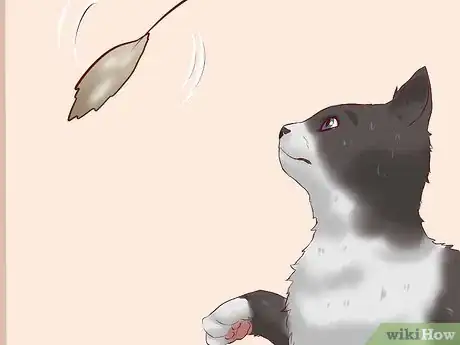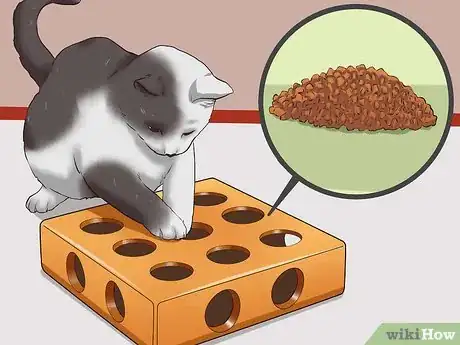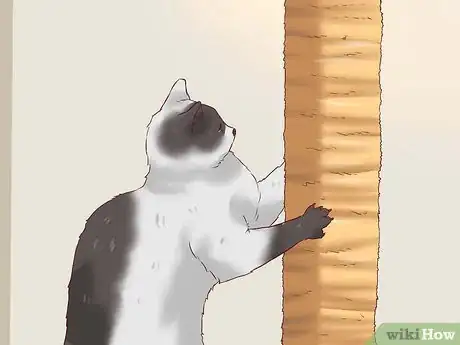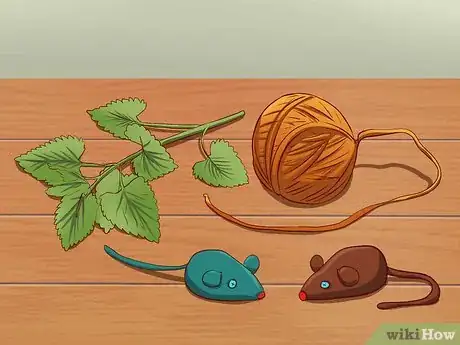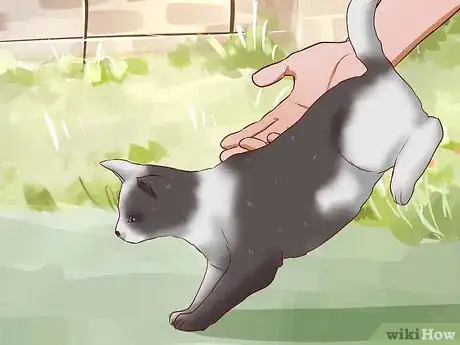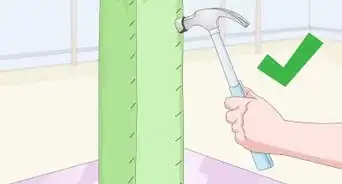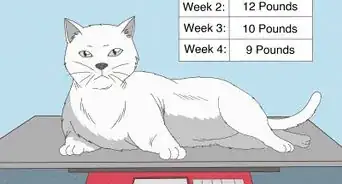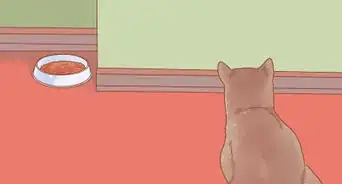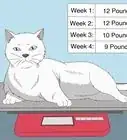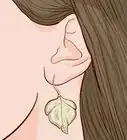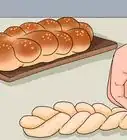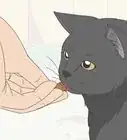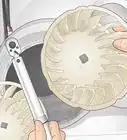This article was co-authored by Pippa Elliott, MRCVS. Dr. Elliott, BVMS, MRCVS is a veterinarian with over 30 years of experience in veterinary surgery and companion animal practice. She graduated from the University of Glasgow in 1987 with a degree in veterinary medicine and surgery. She has worked at the same animal clinic in her hometown for over 20 years.
There are 12 references cited in this article, which can be found at the bottom of the page.
This article has been viewed 41,647 times.
It's easy to overlook gradual weight gain in your cat. You may even think that an overweight or obese cat is just a natural thing, but it isn't. If your cat is becoming overweight and more sedentary, you need to take action now. Cats carrying too much weight are at risk for serious diseases and tend to have shorter lifespans than leaner felines. As the owner, it’s up to you to control your cat's access to food and help him lose weight. By controlling food, providing exercise, and allowing your cat to lose weight gradually, your stout feline will eventually become stealthy and lean, having more energy to play with you.
Steps
Helping Your Cat Lose Weight
-
1Prevent complications from rapid weight loss. Avoid drastic measures that could cause rapid weight loss in your cat. This could lead to a serious liver condition called hepatic lipidosis, where excess fat that is broken down accumulates in the liver. This makes your cat feel ill and decreases his appetite, setting up a vicious cycle of more body fat breakdown and fat accumulating in the liver.
- If you suspect your cat has hepatic lipidosis, get your cat prompt medical treatment at a veterinary hospital. It's a life-threatening condition that requires immediate treatment.[1]
-
2Recognize the health risks of being overweight. Overweight cats are more likely to develop diabetes, where the body doesn't create or manage insulin and blood sugar levels properly. If a cat develops diabetes, it may be manageable through gradual weight loss and a high-protein diet alone, while other cats will need daily insulin injections by their owners for the rest of their life. Obese cats are also at risk to develop painful osteoarthritis due to years of excess weight stressing the bones and joints.[2] In addition, they are at risk of developing high blood pressure, heart disease, and some forms of cancer.
- Obese and overweight cats have a tendency to be less energetic, sleep more, and have fewer interactions with their families. This is how they get the reputation of being fat and lazy.
EXPERT TIPDr. Elliott, BVMS, MRCVS is a veterinarian with over 30 years of experience in veterinary surgery and companion animal practice. She graduated from the University of Glasgow in 1987 with a degree in veterinary medicine and surgery. She has worked at the same animal clinic in her hometown for over 20 years.Veterinarian
 Pippa Elliott, MRCVS
Pippa Elliott, MRCVS
VeterinarianPippa Elliott, a licensed veterinarian, advises: "Obesity is strongly linked to diabetes in cats. However, all is not lost. If diabetes is spotted early and the cat is put on a successful weight loss program, a percentage of patients do revert to being non-diabetic again."
Advertisement -
3Create a personalized plan with the veterinarian. The vet will do a thorough examination to make sure there are no underlying health issues. The vet can then guide you on to the type and amount of food you should feed your cat. You'll also be told how much weight your cat should lose each month and how much weight he should lose overall. Your vet will probably recommend that your cat lose a quarter pound a week or one pound a month, depending on your cat's frame, size, breed, and sex.[3]
- You may want to get a measuring cup with 1/8th measure increments. This will help measure the appropriate amount of food for your cat.
-
4Feed your cat a high-fiber cat food. Look for commercial cat foods that are high in fiber and can be fed "as-is" or mix 1 to 2 teaspoons of a powdered fiber supplement into wet food. You can also feed 1 to 2 tablespoons of canned plain pumpkin to add fiber to a regular diet. If you add powdered fiber or pumpkin instead of the commercial high-fiber food, cut back on the amount of cat food by 1 to 2 tablespoons at the same time.[4]
- If you're having trouble getting your cat to eat the less flavorful high-fiber food, add a little water that's been drained off of a can of tuna. This can entice your cat to eat it.
- Fiber is an important form of carbohydrate that will take a while for your cat to digest, making him feel fuller without contributing too many calories. High-fiber foods will give important nutrients and keep your cat from eating too many calories.
-
5Feed your cat high-protein food. Look for a commercially prepared high-protein food or have a trained pet nutritionist create a homemade diet for your cat. This is important because cats need the amino acid taurine in their diets or they'll develop heart and vision problems. While high-protein foods are generally tastier for cats, they might not be as filling or satisfying to a cat used to eating more food.[5]
- Note that a cat with kidney disease should not be placed on a high protein diet since it will further damage the kidneys.
- If you do chose to gradually switch cat food, do so over a period of one to two weeks. The first two days mix ¼ new food with ¾ old food. The next four days mix ½ new food with ½ old food. The next 2 to 4 days mix ¾ new food with ¼ old food. If the cat leaves the old food in the dish, make a more gradual transition to the new food. If he absolutely refuses the new food consult your veterinarian for advice.[6]
-
6Reduce your cat's meal sizes. You might try keeping your cat's regular food, just offering a smaller portion. Use the measuring cup to measure out the recommended amount on the cat food label and feed that amount. If it's more than what your cat normally eats, cut down accordingly, since some manufacturers are fairly generous in their serving sizes. A good rule of thumb is to decrease the amount of food fed by 10%.[7]
- It is important to understand that if your cat was used to having food available to eat at all times, you will need to begin feeding your cat two or three times a day. Since your cat has been overeating, you need to control feeding times.
-
7Monitor your cat's weight loss. Before starting your cat on a diet, write down your cat's weight on a calendar or notebook. Weigh your cat every week while he's dieting. It's easy to do this by holding your cat in your arms, stepping on a bathroom scale and then weighing yourself after you place the cat down. Subtract this number from your first number to give you your cat’s weight.
- Remember the goal is for your cat to lose no more than ¼ pound a week or 1 pound a month.
- If you find after two weeks that no weight has been lost, cut down portion sizes by 10%. If your cat still hasn't lost weight after 2 more weeks, talk again with your veterinarian.
Keeping Your Cat Active
-
1Play with your cat. You might try tossing a ball or crumpled up piece of paper across the room for him to chase. Or, buy a few fuzzy toys for him to bat around, buy a feather toy on a wand to wave for your cat to jump at, or use a laser cat toy for a fun game of catch the dot. Playing with your cat will keep his mind off food and help him become more active.
- Try to play with your cat for 10 to 15 minutes a day. This will give him much needed exercise. [8]
-
2Let your cat play with puzzle toys. Buy a couple of food puzzle toys. Fill the toys with your cat's food so he can work at it to get the food. This will occupy his attention for quite a while as he bats the toy around and chases it to get to the food.
- Puzzle feeders offer environmental enrichment to indoor cats that don't have the opportunity to chase and hunt for food.[9]
-
3Get your cat a scratching post. Cats can use scratching posts to let off extra energy, mark their territory, and shed the outer layers of their nails.[10] A scratching post or climbing tower can give your cat some much needed exercise.
- Giving your cat the chance to play will make him happier and less likely to trouble you with bad behavior.[11]
-
4Use catnip to get your cat moving. Sprinkle catnip on new toys to get your cat's interest. You may find that your cat is instantly motivated and playful, which will increase his activity levels.[12] [13] Take care not to use catnip constantly, or your cat may become desensitized to its effects.
- Some cats aren't interested or sensitive to catnip, so you may just need to offer a variety of toys instead.
-
5Let your cat outside. Take a few toys outside and try to engage your cat while playing in the yard. You may find that your cat is interested in exploring his surroundings. Or, if your cat is up to it, you may put him on a leash and take him for a walk around the neighborhood. Make sure the harness fits comfortably and he can't slip out of it.[14]
- If you're cat is only an inside cat, consider letting him use an outdoor enclosure.[15] This will let him experience the outdoors in a contained space.
Warnings
- If your cat refuses to eat at any time during the diet, immediately contact your veterinarian for advice.⧼thumbs_response⧽
- Never let your dieting cat go a day without food. Hepatic lipidosis can occur in as little as two days without food or eating..⧼thumbs_response⧽
References
- ↑ Tilley, L. A. Blackwell’s Five-Minute Veterinary Consult: Canine and Feline. Wiley-Blackwell. 2011
- ↑ Nelson, R. A. Small Animal Internal Medicine, Fifth Edition. Mosby. 2013
- ↑ http://www.vcahospitals.com/main/pet-health-information/article/animal-health/creating-a-weight-reduction-plan-for-cats/391
- ↑ http://www.allfelinehospital.com/getting-your-cat-to-lose-weight.pml
- ↑ http://www.petmd.com/blogs/nutritionnuggets/cat/dr-coates/2015/july/high-protein-diets-are-best-weight-loss-cats-32914
- ↑ http://www.vcahospitals.com/main/pet-health-information/article/animal-health/creating-a-weight-reduction-plan-for-cats/391
- ↑ http://www.vcahospitals.com/main/pet-health-information/article/animal-health/creating-a-weight-reduction-plan-for-cats/391
- ↑ https://www.petmd.com/cat/wellness/evr_ct_exercising_with_your_cat_a_how_to_guide
- ↑ ::http://www.catbehaviorassociates.com/why-does-my-cat-need-a-puzzle-feeder/
- ↑ http://www.petplace.com/article/cats/keeping-your-cat-healthy/exercise-play/is-your-indoor-cat-bored-12-ways-to-prevent-boredom
- ↑ https://indoorpet.osu.edu//cats/problemsolving/activity
- ↑ https://books.google.com/books?id=xYfgCAAAQBAJ&pg=PA255&lpg=PA255&dq=catnip+to+increase+cat%27s+activity+levels&source=bl&ots=eYiEuz2ea_&sig=sFKD9qWtPnddZv0J2j_YhTU5lzk&hl=en&sa=X&ved=0CCEQ6AEwAGoVChMIx--Czea1xwIVhyqICh0ygAGY#v=onepage&q=catnip%20to%20increase%20cat's%20activity%20levels&f=false
- ↑ http://www.petplace.com/article/cats/keeping-your-cat-healthy/exercise-play/is-your-indoor-cat-bored-12-ways-to-prevent-boredom
- ↑ http://www.everydayhealth.com/pet-health/ten-cat-exercises.aspx
- ↑ http://www.quickanddirtytips.com/pets/cats/keeping-indoor-cats-active-and-happy?page=1
About This Article
You can keep your cat from becoming fat and lazy by helping it gradually lose weight through good diet and exercise. To do this, start feeding your cat a food that’s high in fiber and protein, which will help it feel full without eating too much. You may also consider reducing your cat’s meal sizes by 10% to help it lose weight. In addition to a good diet, you should play with your cat for 10-15 minutes each day to keep it from becoming bored and overeating. You can try using a feather wand or putting out a puzzle toy for it to play with. To learn how to use catnip to motivate your cat to play, read more from our Veterinarian co-author!
